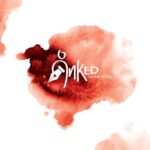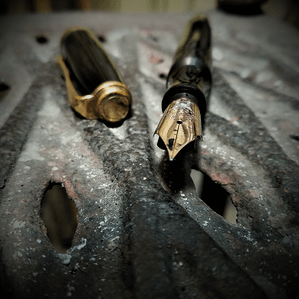Soennecken – once upon a time, long, long ago…
Friedrich Nietzsche – German philosopher, cultural critic, composer, poet, philologist, and a Latin and Greek scholar of extraordinary sharp mind and a fathomless knowledge pool. The profound influence on Western philosophy and modern intellectual history that his work has exerted needs no elaboration. Naturally, when Nietzsche put on record his appreciation for a German pen, it continues to stoke our interest, inquisitiveness even, to date. To cut a long story short, yes, Nietzsche was appreciating a Soennecken.
Soennecken – a company founded in 1875 to manufacture pens and inkwells and is often considered to be the first German company to manufacture fountain pens (that were already included in its catalogue in 1890). The founder of the company, Friedrich Soennecken is credited with having invented the round writing type that we use till date and a number of office stationery items like the ring binder and the hole punch, but it will be the fountain pens that his company manufactured that he will be remembered forever. For Soennecken was not only one of the most important manufacturers of pens in Germany but was also credited with having made pens of such impeccable quality that they alone are enough to provide Soennecken immortality.
The period between the two great wars is often identified as the golden age of fountain pens and it was in this period that Soennecken was the undisputed leader of the pack, churning out with mechanical precision masterpieces that are sought out by connoisseurs to date. Soennecken pens were undoubtedly of exemplary quality – each an example of ingenious German manufacturing prowess, the kind of detailing that we just cannot comprehend today, to the extent of lending credence to the term “German over-engineering”.
Terming Soennecken the “first among equals” as a time when Fountain Pen making was literally (and historically) at its peak, will not be an exaggeration and it is a pity that the company succumbed in 1967, most ingloriously, unable to withstand the post war onslaught of the ball point pens.
Pelikan, Osmia, Kaweco, Montblanc and Soennecken – those, sure were the days for Fountain pen lovers in Germany and I will be failing in my duties if I do not point out the fact that among them, it was Soennecken that had the maximum number of models on offer, along with a rainbow of colours that they were offered in. And, this is not taking into account the offerings of the sub brand Soennecken had for the Swiss market for example!
This is off-course not to say that the World War II was not exacting to the company – its factories in Bonn (where more than 2000 people worked at one time) were obliterated and it was only in 1945 that the son and the grandson of the founder revived the Soennecken legacy by reintroducing two lines of the world dominating Präsident and the Rheingold models. Piston fillers were reintroduced soon after, but by then, the dye had been cast. Perhaps, the die was cast even before, when Soennecken had refused to move its factory out of Nazi Germany (Montblanc did). In hindsight, the decisions not to retain the original logo – an eagle clasping a pen with its talons, or the stubborn refusal to meet the onslaught of the ball point pens by compromising on the quality (Montblanc went in for second tier pens with thinner barrels) were akin to committing Selbstmord.
Soennecken Fountain pens were relatively less prolific in terms of usage in India, perhaps due to political reasons (British Raj and all that, you know) or because of the simple fact that they were pretty dear in the context of the socio-economic state of those times. And perhaps it was this reason why these beauties are such rare finds in the Indian market for heritage fountain pens. The ones that are there are mostly in the collection of connoisseurs – collectors who consider them invaluable, adding to their scarcity and naturally ensuring the push-pull tug of demand and supply jacking the prices through the stratosphere. The fact that when the odd one surfaces, the dealers almost inevitably shun the Indian market and seek buyers in the net, lured by the prospect of earning in USD, also adds to the dryness in the market.
The Soennecken 111 Extra that I have is older than I am, was born in the last century (around 1950 or thereabouts) in the cold climes of Europe and was destined to spend most of its life in the heat and humidity of tropical India. Has it made a difference to it? The long and arduous trek through life, silently filling its innards with ink laced with harmful chemicals and converting the thoughts of its owners on paper? Did all that scratching, often on coarse paper of suspect quality, damage the fine balance of its tines? Eroded the EF tip perhaps? Has the resin body, exposed to the heat and grime, developed just the kind of fine cracks that are not visible to the naked eyes? Discoloration? Have the mechanical parts, subject to wear and tear capable of performance these days? Surely it is way beyond its retirement age and thus, though it remains a conversation piece, is not good enough of the war horse that it was?
Well yes and no. Yes, my Soennecken is old. And no, age has neither withered it, not robbed it of its ability to get into the thick of the battle, only to emerge victorious. At its height of popularity, it was said that “a Soennecken is für immer”. How true! Soennecken fountain pens were not created with expiry dates – they were, and they continue to be forever!
A Quick End Note: The clip is delightfully Art Deco (if I know what the term means) and has, hold-your-breath, seven facets – look closely and you are sure to mistake it for something that has been twisted into perfection by God Himself – what else can explain the intricate lines that are oh, so refreshingly clean at the same time? And the surprisingly heavy feel of the Soennecken 111 is because of the brass piston which makes it a stunning study in sturdiness.

